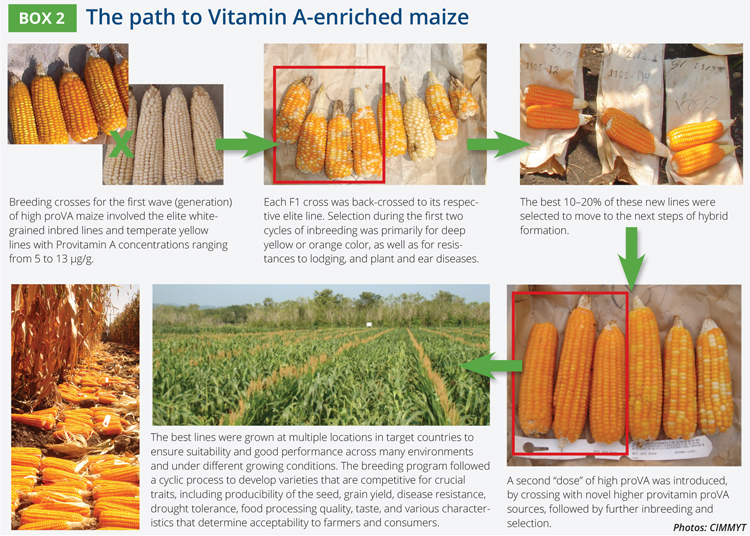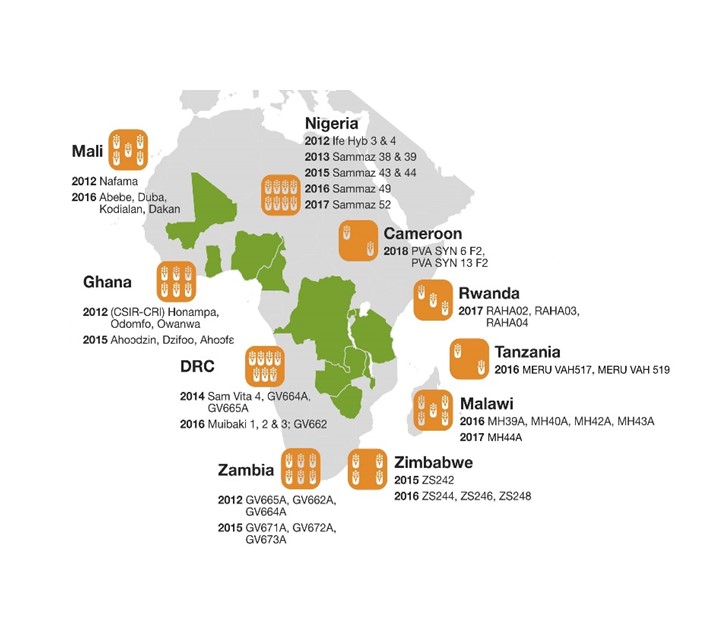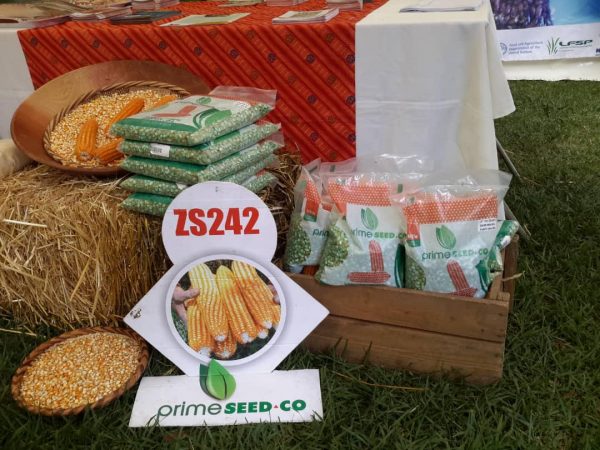Golden maize varieties (High provitamin A)
Summary
Maize is the preferred staple food for millions of people in Sub-Saharan Africa, but common varieties grown by farmers have low levels of vitamins and minerals. This situation is contributing to widespread malnutrition and hidden hunger on the continent, with 50% of children between 0.5 to 5 years suffering from vitamin A deficiency according to World Health Organization. Insufficient intake of vitamin A is the leading cause of preventable blindness in children, it compromises the immune system increasing the risk of death from diseases like measles, diarrhea and respiratory infections. Conventional breeding techniques allow to raise the level of provitamin A in maize crops and offer a viable avenue to sustainably improve nutrition in rural communities and add value for farmers. Kernels of golden maize are packed with beta-carotenoid which give its characteristic orange color, and after ingestion these compounds are converted into vitamin A by enzymes as per the need in the body, which results in balanced nutrition unlike is the case for synthetic supplements. A large range of golden maize varieties have been released and are marketed in Sub-Saharan Africa, and through close collaboration between seed companies, farmers, policy makers and researchers these seed technology has been successfully scaled in major growing areas.
About the Solution
Golden maize varieties are developed using lines from Central and South America that are naturally provitamin A enriched and crossing these with elite natural land races and hybrid lines of maize that got high yield potentials and improved agronomic traits such as disease resistance and drought tolerance. The beta-carotene in golden maize is preserved during storage and processing, unlike common varieties of maize in which a large amount of provitamin A is oxidized and forms off-flavors before the food is consumed. Novel breeding techniques enable rapid development of golden maize varieties that contain 2 to 3 times more provitamin A than the original parent material from which it was developed, reaching levels that allow to fulfil a large part or all of the nutritional requirements in communities who depend on this food as staple. Genomic modification is further used to silence the activity of enzymes that breakdown provitamin A, and does not reduce yield potential and interfere with other agronomic traits. Scaling programs for golden maize in Sub-Saharan African countries demonstrated to be highly effective in reducing vitamin A deficiency and related health issues in children and adults, and have boosted maize value chains at local and regional scale by increasing the production and value of grain.
Provitamin A fortified maize varieties are offering a cost-effective approach to tackle malnutrition in regions where people eat a lot of maize, and could provide half of the daily vitamin A requirement. Suitable varieties of golden maize are available for all major growing areas in Sub-Saharan Africa that are ready to be scaled for addressing malnutrition and increasing producer's profits margins. Acceptability studies have shown that consumers do not object to the color and like the flavor of provitamin A enriched maize. There is a range of open pollinating lines of golden maize that can be multiplied by community and private enterprises that enable to rapid scaling and commercialization in growing areas. Hybrid types of provitamin A enriched maize typically possess other improved traits that make them highly appropriate for farming systems where production is limited by diverse challenges, but
Breeders have released more than 50 varieties of golden maize in Sub-Saharan Africa that contain high levels of provitamin A, i.e., 8 to 15 parts per million, that allow to fulfill the prescribed intake of antioxidants by children and adults for nutritional health, or at least a large part of it. There are specific lines of golden maize that are adapted for cultivation in mid-altitude highlands and lowlands with humid to semi-arid climate regimes, which possess desired agronomic traits for growing areas and reach similar yields as non-biofortified hybrids. Golden maize varieties that are tolerant to dry spells and low rainfall, and resistant to common pests and diseases, or chemical control agents, are developed from parent materials with those traits using novel breeding techniques and genomic modification. There are a large number of multipliers and private seed companies that are marketing open pollinating and hybrid golden maize varieties in multiple countries across Sub-Saharan Africa which have proven to increase food sufficiency and dispensable incomes of farmers.
Golden maize varieties are cultivated following best planting methods, and soil and fertilizer management prescribed for particular growing areas and conditions. Appropriate inputs and formulations of inorganic fertilizers are widely shown to get farmers higher yields from biofortified maize because the applied nutrients are addressing limitations in soils that make the crop to grow stronger. On farmlands with low soil fertility status, like there are many in Africa, it is recommended that the use golden maize is combined with legume intercropping or rotation, manure application and mulching in order to improve availability of nutrients and water for the golden maize crop.
Commercialization
Commercially available
Solution Images
Institutions

Accompanying Solutions
Drought tolerant varieties (DTMA, WEMA, others), Specialized pre-plant fertilizer blending and N topdressing, Maize-legume rotation and intercropping, Fall armyworm control in maize production (e.g. FORTENZATM Duo)



